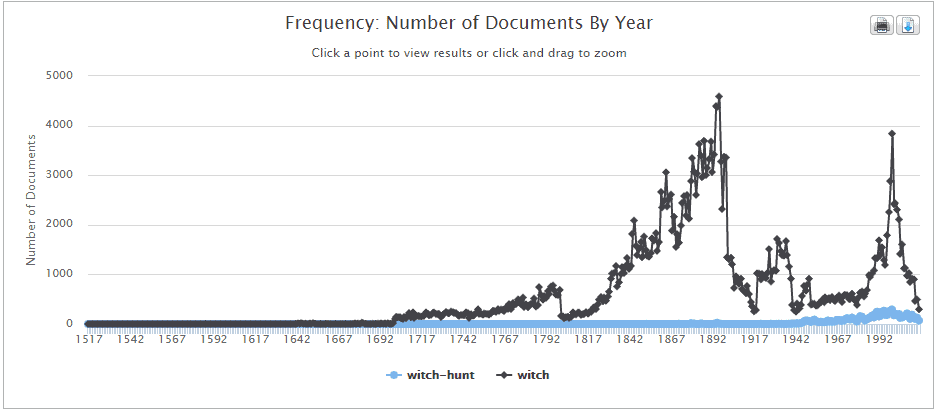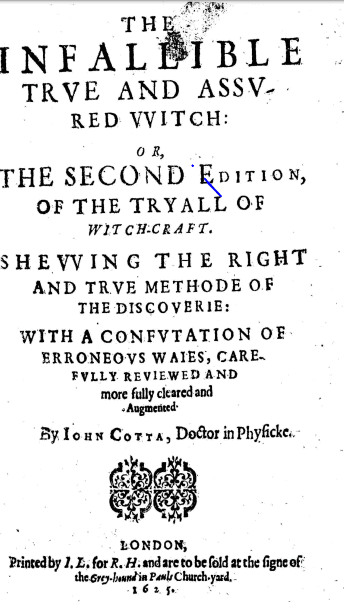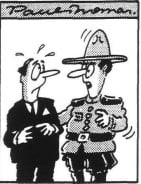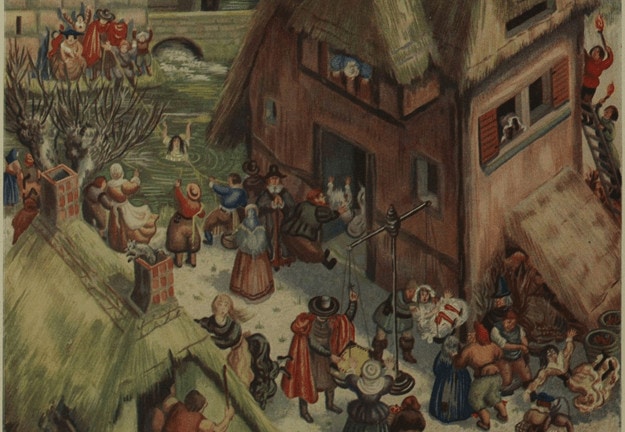│ by Eloise Sinclair, Gale Ambassador at the University of Durham │
For many of us, the term ‘witch-hunt’ conjures up images of spell books, familiars and haggard old women being hauled from their homes by angry mobs. Although scenes such as these took place in numerous witch-hunts, they are not their defining feature. Using the Term Frequency tool in Gale Primary Sources reveals that the number of documents containing the term ‘witch’ peaked at the end of the nineteenth century and rose rapidly again in the second half of the twentieth century. ‘Witch-hunt’ similarly came to be used more frequently in the last sixty years. This demonstrates that these two terms are not solely linked to the persecution of magical witches; instead they have, over the centuries, taken on a different meaning. This article uses Gale Primary Sources to explore what constituted a witch and how witches were dealt with in different eras and political climates.

Witch-hunts in the seventeenth and eighteenth centuries
John Cotta, in his 1625 publication, The Infallible True And Assured Witch clearly defines what constituted a ‘witch’ in the seventeenth century: a person with magical ability. He makes a distinction between the “imposter…who pretendeth truth, but intendeth fallhood” and “the Witch” who does “strange and supernaturall workes”. Therefore, in order to prosecute a witch, one had to differentiate between the two. Although, not believing in it himself he explains that a water test was used to do this. It was thought that water contained the “power of God”, and so rejected witches. They were unholy and unable to establish a relationship with God.

Looking at contemporary newspaper articles from the 17th and 18th Century Burney Newspaper Collection reveals other methods used to identify witches. An article from the Athenian Gazette tells of ordeals involving drinking water, water submersion and fire. Another article provides an insight into how a water ordeal was carried out. A woman “was dragged out of her House”, taken “two Miles” to “a Mill-Pond, stripp’d of her upper Cloaths, her Legs tied together, and, with a Rope about her Middle, thrown into the Water”.
This source is particularly useful for those studying the nature of crime and punishment in this period. It demonstrates that illegal public trials, attended by as many as “200 Spectators” were carried out by ordinary parishioners. The presence of witchcraft clearly reflected negatively on the local community. In this case it prompted “above 40 Persons” to act of their own accord, “plunging her” into the pond. This crime proved difficult to prosecute and “only three” were charged with manslaughter.
Witch-hunts during the Cold War
Jumping forwards many years, we reach the Cold War. Cold War fears created a climate which enabled Senator Joseph McCarthy to rise to prominence, spearheading investigations into any individual with links to left-leaning organisations. A new era of legislation, public trials and a “poisoned McCarthy atmosphere” was born in 1950s America. Documents from Archives Unbound are especially beneficial for monitoring the growth of the McCarthy witch-hunts. A pamphlet in the collection Fight for Racial Justice and the Civil Rights Congress recalls how on the 4th June 1951 the Supreme Court “set aside the First Amendment” due to the belief that there was a “Communist conspiracy” in the U.S. which “constituted a “clear and present danger” to the Government”. Following this ruling “125 Communist leaders” were indicted. Countless “non-Communists” were “branded “security risks”” and “scientists, teachers, writers, artists and other professionals” came under attack.

Arthur Miller was one such individual, questioned by the House Un-American Activities Committee. Although these witch-hunts took on a completely different form to those years before, the attack on civil liberties is present in both. This link was made explicit by Miller in his play, The Crucible. Howard Lowther Beaver identifies the commonalities, “the autocratic power of the court, the arrogance of the examination, the vacillating witnesses, the spread of guilt by association, and finally that same topsy-turvydom of Anglo-Saxon justice whereby a man is guilty until he proves himself innocent” in his article in The Times Literary Supplement.
Witch-hunts “to identify every known or alleged gay man in the Ottawa area”
Homosexuals in 1960s Canada were treated similarly. Following the taking of explicit photographs of government officials a hunt was initiated by the Royal Canadian Mounted Police “to identify every known or alleged gay man in the Ottawa area” as they believed “they were vulnerable to Soviet blackmail”. The ambassador to Moscow, John Watkins “died of a heart attack” following his interrogation in 1964. A “fruit machine” was devised to detect homosexuality, measuring “pupil size, palm sweat and blood flow as sexually provocative images were shown”. By 1967, eight years after the investigations began, the police had recommended the “dismissal or demotion” of 395 men.

Recent witch-hunts
Witch-hunts are unfortunately not something of the distant past. A similar documenting of homosexuals took place in 1987 amongst the clergy and in 2013, sixty journalists who had been involved in “the wave of anti-government protests” in Turkey were “forced from their jobs”. Many claimed that this was part of a large-scale government attempt to silence opposition. Most of the journalists came from private newspapers. Further outrage was sparked when the body who supplies student loans refused to grant them to students involved in boycotts or demonstrations. The government crack-down quickly began to resemble a political purge. Countless examples of investigations and suspension of civil liberties are available in the newspaper archives of Gale Primary Sources.
Over the centuries people on the peripheries of society or those who criticised authority have been branded as threats and denied basic human rights. They have been hunted out, interrogated and used as public scapegoats. Primary sources allow us to discover their stories and identify parallels in today’s society, enhancing our scrutiny of contemporary events.
Blog post cover image citation: “The Witch Hunt.” Christmas Number. Illustrated London News, 22 Nov. 1939, p. 46. The Illustrated London News Historical Archive, 1842-2003, http://tinyurl.gale.com/tinyurl/CFv8e4

